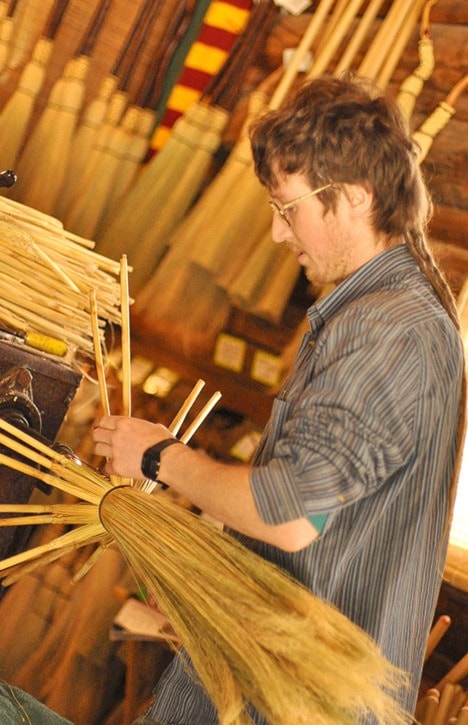After a couple of decades of twisting and turning handles and weaving broomcorn, North Woven Broom Co. owners Rob and Janet Schweiger decided to work toward retirement. They didn’t have to look too far for a successor, though — and their nephew, Luke Lewis, is now the one doing the twisting, turning and weaving.
“I’ve been in and out of the shop since I was pretty little,” Lewis said. “I never thought I would work here, but it’s a place I’ve always known of. ... Even having grown up always knowing about the brooms, it’s amazing how much there is to learn — sweeping styles and what a good broom feels like.”
His mom and Janet are sisters, and Lewis, who was born in Nelson and grew up near Toronto, visited Crawford Bay regularly with his family. His parents, both teachers, had an organic dairy farm and they encouraged creativity.
“The way my home was growing up, it was always about art and doing things with your hands,” Lewis said.
He took environmental studies at York University from 2006-2011, and worked in Jasper National Park and travelled each summer. When he wanted to learn to build a yurt — a round tent-like structure based on the tents used by central Asian nomads — he went to the Yukon to learn to make buckskin.
But when he visited his aunt and uncle during their winter vacation in Arizona, they brought up the idea of him taking over the business — they bought the Crawford Bay shop in 1992 from the previous owners — which is complemented by their daughters’ Granville Island Broom Co. in Vancouver.
This wasn’t something Lewis could just jump into, though — there was a steep learning curve to creating the North Woven Broom style, which employs a rarely-seen weave with two layers of unprocessed broom corn to give the broom’s head both strength and a unique bulbous look.
“There are very few people doing this, especially the weaving of the stems,” Lewis said. “It’s a very old style coming from Shakers, who were really the people who popularized the flat broom.”
The technique Lewis uses is about 200 hundred years old, and machines used in the shop aren’t particularly modern, either. A flattener is from the 1870s, and a machine from the 1930s is used to make straight-handled brooms.
“With this machine, they would have stopped doing the weaving, but we’ve modified it,” said Lewis.
Even with the machines, the work is physically demanding, with muscle memory working to create the right tension — pressure that ensure good callouses are developed.
“My uncle often says, ‘We have callouses in places people don’t have places,’ ” said Lewis. “There’s a lot of contact.”
The challenges are worth it, though, to bring a level of style to a tool that can be found in every home.
“This is celebrating that and adding a level of beauty,” said Lewis. “I feel my aunt and uncle have really brought art to broom making.”
The art is evident in some of the more unusual handle styles, particularly manzanita, which Rob and Janet have long gathered while on winter vacation in Arizona.
“I can get lost in it,” Lewis said. “It’s so beautiful to look at.”
That can be said of all of the company’s products, which have been used in a wide range of TV shows (Road to Avonlea and Star Trek: Enterprise), movies (Shanghai Noon and Bewitched) and stage productions (Broadway’s Fiddler on the Roof and the Lyric Opera of Chicago’s La traviata).
Of course, they’re probably best known for their use as promotional items by Raincoast Books, the Canadian publisher of Harry Potter and the Order of the Phoenix and Harry Potter and the Deathly Hallows, which required a total of 300 full-sized brooms and 500 miniature brooms.
And while visitors are quick to identify the brooms with the shop, they are also mesmerized by the number of artisans in Crawford Bay, of which Lewis is proud to be one.
“There is so much to do and see here,” he said. “It’s a whole experience to be here. It’s not just brooms and it’s not just the forge, it’s everything.”
